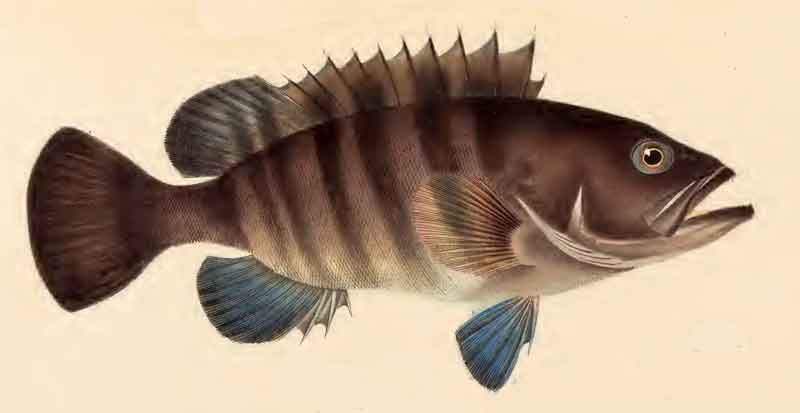
Superregnum: Eukaryota
Cladus: Unikonta
Cladus: Opisthokonta
Cladus: Holozoa
Regnum: Animalia
Subregnum: Eumetazoa
Cladus: Bilateria
Cladus: Nephrozoa
Superphylum: Deuterostomia
Phylum: Chordata
Subphylum: Vertebrata
Infraphylum: Gnathostomata
Megaclassis: Osteichthyes
Superclassis/Classis: Actinopterygii
Classis/Subclassis: Actinopteri
Subclassis/Infraclassis: Neopterygii
Infraclassis: Teleostei
Megacohors: Osteoglossocephalai
Supercohors: Clupeocephala
Cohors: Euteleosteomorpha
Subcohors: Neoteleostei
Infracohors: Eurypterygia
Sectio: Ctenosquamata
Subsectio: Acanthomorphata
Divisio/Superordo: Acanthopterygii
Subdivisio: Percomorphaceae
Series: Eupercaria
Ordo: Perciformes
Subordo: Percoidei
Superfamilia: Percoidea
Familia: Serranidae
Subfamilia: Epinephelinae
Genus: Epinephelus
Species: Epinephelus bruneus
Name
Epinephelus bruneus Bloch, 1793
Epinephelus bruneus, the longtooth grouper, is a species of marine ray-finned fish, a grouper from the subfamily Epinephelinae which is part of the family Serranidae, which also includes the anthias and sea basses. It is found in northwest Pacific in eastern Asia.
Description
Epinephelus bruneus has an elongate body which has a standard length which is 3.0 to 3.6 times its depth. The dorsal profile of the head between the eyes is convex. The preopercle has an angle where the serrations are notably enlarged. There is a small spine on the upper edge of the gill cover and this upper edge is convex.[3] The dorsal fin contains 11 spines and 13-15 soft rays while the anal fin has 3 spines and 8 soft rays.[2] It has 64-72 scales in its lateral line. The larger adults are dark greyish brown in colour, and may be marked with faint blotches on their nbacks, although these may be absent. They also have a covering of small grey spots on their bodies which form short longitudinal lines and creating a mottled pattern. The lower margin of the anal fin and the lower corner of caudal fin have white edges. The juveniles are pale yellowish brown in colour, with 6 irregular, diagonal dark bars within which there are irregular pale spots. The first of these bars extends from nape to eye and the last is on the caudal peduncle. There are 3 dark brown bands which radiate from lower part of eye and some juveniles have greenish yellow membranes between the rearmost spines of the dorsal fin.[3] The maximum published total length for this species is 136 centimetres (54 in), although the most common length is around 60 centimetres (24 in), and the maximum recorded weight is 33 kilograms (73 lb).[2]
Distribution
Epinephelus bruneus is found in the Western Pacific Ocean where it occurs from southern Japan and Taiwan and along the coast of Asia from southern Korea to Hainan and Hong Kong in southern China.[3] However, see taxonomy below.
Habitat and biology
Epinephelus bruneus is found over rocky reefs and over areas of muddy substrates. Adults are found at depths of 20 to 200 metres (66 to 656 ft).[3] They are also found over coral and artificial reefs, Juveniles are found in shallower water, less than 5 metres (16 ft). The biology of this species is little known.[1]
Taxonomy
Epinephelus bruneus was first formally described in 1793 by the German physician and naturalist Marcus Elieser Bloch (1723–1799) with the type locality given as "Norway", apparently an error for China.[4] Some authorities have split E. bruneus into two species, E. bruneus and E. moara and the exact distribution of these two species still require to be determined. E. moara appears to be found in Japan, Korea, Taiwan and China as afar south as Fujian.[5]
Utilisation
Epinephelus bruneus is considered an excellent fish for eating and is caught using hand lines, longlines and trawls.[3]
References
To, A.; Amorim, P.; Choat, J.H.; Law, C.; Ma, K.; Myers, R.F.; Rhodes, K.; Sadovy, Y.; Samoilys, M.; Suharti, S. (2018). "Epinephelus bruneus". IUCN Red List of Threatened Species. 2018: e.T135381188A100573599. doi:10.2305/IUCN.UK.2018-2.RLTS.T135381188A100573599.en. Retrieved 19 November 2021.
Froese, Rainer; Pauly, Daniel (eds.) (2019). "Epiphenelus bruneus" in FishBase. December 2019 version.
Heemstra, P.C. & J.E. Randall (1993). FAO Species Catalogue. Vol. 16. Groupers of the world (family Serranidae, subfamily Epinephelinae). An annotated and illustrated catalogue of the grouper, rockcod, hind, coral grouper and lyretail species known to date (PDF). FAO Fish. Synopsis. Vol. 125. FAO, Rome. p. 119-120. ISBN 92-5-103125-8.
Eschmeyer, William N.; Fricke, Ron & van der Laan, Richard (eds.). "Epinephelus bruneus". Catalog of Fishes. California Academy of Sciences. Retrieved 28 June 2020.
Liu, M. (2018). "Epinephelus moara". IUCN Red List of Threatened Species. 2018: e.T118360643A118360649. doi:10.2305/IUCN.UK.2018-2.RLTS.T118360643A118360649.en. Retrieved 28 June 2020.
Retrieved from "http://en.wikipedia.org/"
All text is available under the terms of the GNU Free Documentation License

